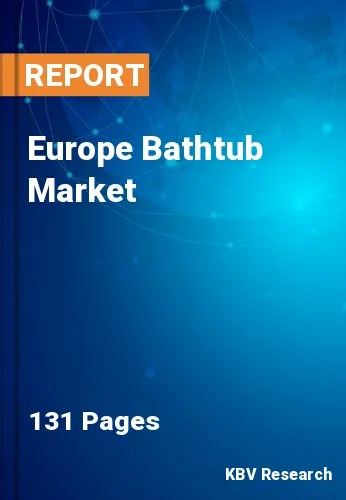The Europe Bathtub Market would witness market growth of 3.7% CAGR during the forecast period (2023-2030).
In response to the demand for personalized solutions, manufacturers are innovating with customizable and modular designs. Modular systems allow users to configure their bathing space according to preferences, combining different components for a tailored experience. This innovation caters to the desire for flexibility in design and functionality. Advancements in materials include the use of composite and hybrid materials, combining the benefits of different substances. Fiberglass-reinforced composites, for example, provide durability and flexibility, allowing for intricate designs and shapes that may not be achievable with traditional materials.
Furthermore, innovative bathtubs incorporate chromotherapy and color therapy through integrated mood lighting systems. Different colors are used to evoke specific emotions or enhance relaxation during bathing. By adjusting the illumination to suit their mood or personal preferences, individuals can generate an experience that is both immersive and one-of-a-kind. These integrated systems leverage LED or other advanced lighting technologies to illuminate the bathtub surroundings with a spectrum of colors. The placement of lights is carefully designed to create an ambient and visually stimulating experience for the bather. Matte surfaces contribute to a contemporary aesthetic and offer a tactile and anti-slip element. Textured finishes enhance both visual appeal and sensory experience.
The European Union (EU) is experiencing a notable trend of urbanization, with an increasing number of people choosing to reside in urban areas. As per the data from the Eurostat, in 2021, broadly similar shares of the EU population were living in predominantly urban regions (40.5 %) and intermediate regions (38.7 %), while the remaining fifth (20.8 %) of the EU population lived in predominantly rural regions. Furthermore, from 2021 to 2027, efforts will be made to enhance the urban aspect of cohesion policy. This will involve the establishment of a new European Urban Initiative (EUI) and allocating at least 6% of the European Regional Development Fund (ERDF) towards sustainable urban development strategies. Therefore, increasing urbanization and new construction projects in Europe will assist in the growth of the regional market.
The Germany market dominated the Europe Bathtub Market by Country in 2022, and would continue to be a dominant market till 2030; thereby, achieving a market value of $992.6 million by 2030. The UK market is exhisting a CAGR of 2.7% during (2023 - 2030). Additionally, The France market would experience a CAGR of 4.5% during (2023 - 2030).
Free Valuable Insights: The Global Bathtub Market will Hit $12.8 Billion by 2030, at a CAGR of 4.4%
Based on End-user, the market is segmented into Residential and Commercial. Based on Type, the market is segmented into Alcove Bathtubs, Drop-In Bathtubs, Freestanding Bathtubs, and Corner Bathtubs. Based on Shape, the market is segmented into Rectangular, Square, Oval and Others. Based on Material, the market is segmented into Acrylic, Fiberglass, Porcelain, Cast Iron and Others. Based on countries, the market is segmented into Germany, UK, France, Russia, Spain, Italy, and Rest of Europe.
By End-user
By Type
By Shape
By Material
By Country
Our team of dedicated experts can provide you with attractive expansion opportunities for your business.

